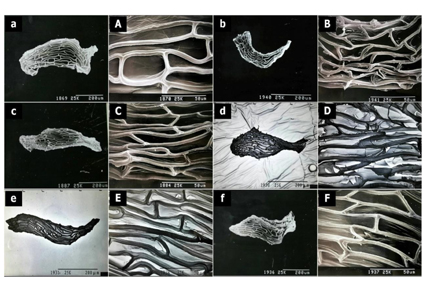Abstract
The micromorphological characteristics of the seeds of 11 species of Pleione have been studied, both qualitatively and quantitatively, to establish whether they are useful for systematic studies of the genus. The quantitative characteristics include seed length (0.237–0.626 μm), seed width (0.053–0.133 μm), seed length/width ratio (2.631–7.279), seed ridge thickness (1.4 E-3–4 E-3μm) and seed volume (1.88 E-4–3.06 E-3 μm3). The cluster analysis result agrees well with the results of previous systematic studies. The cluster analysis shows that: P. coronaria, P. forrestii and P. yunnanensis form a group, while the remaining eight species form a second group, with three subgroups, namely: P. limprichtii, P. pleionoides, P. formosana as group I; P. hookeriana and P. bulbocodioides as group II; and P. praecox, P. scopulorum and P. maculata for group III. All the Pleione species of Sect. Pleione and Sect. Humiles show the fusion of adjacent seed coat cells into a network. The shape of the seeds of P. praecox and P. maculata are very similar--being oval, and the mesh walls of their adjacent seed coat cells are not fused. Within these sections no clear pattern can be seen between the species, but the addition of further species might clarify the differences between Sect. Pleione and Sect. Humiles.
References
Bateman, R.M., Hollingsworth, P.M., Preston, J., Luo, Y.B., Pridgeon, A.M. & Chase, M.W. (2003) Molecular phylogenetics and evolution of Orchidinae and selected Habenariinae (Orchidaceae). Botanical Journal of the Linnean Society 142 (1): 1–40. https://doi.org/10.1046/j.1095-8339.2003.00157.x
Chen, X., Cribb, P.J. & Gale, S.W. (2009) Pleione. In: Wu, Z.Y., Raven, P.H. & Hong, D.Y. (Eds.) Flora of China 25. Science Press, Beijing and Missouri Botanical Garden Press, St. Louis, MO, pp. 325–333.
Cribb, P. & Butterfield, I. (1999) The genus Pleione, second edition. Royal Botanic Gardens, Kew.
Cribb, P. & Butterfield, I. (2017) The enigma of Pleione ‘Frank Kingdon Ward’. Curtis’s Botanical Magazine 34 (2): 133–138. https://doi.org/10.1111/curt.12190
Dai, X.Y., Jiang, M.T., LI, W., Zhao, Y.M., Chen, L., Zhai, J.W., Peng, D.H. & Wu, S.S. (2020) The taxonomic revision of Pleione formosana (Arethuseae, Epidendroideae, Orchidaceae) based on molecular, morphological and cytological analyses. Phytotaxa 477 (1): 60–70. https://doi.org/10.11646/phytotaxa.477.1.4
Gamarra, R., Dorda, E., Scrugli, A., Galán, P. & Ortúñez, E. (2007) Seed micromorphology in the genus Neotinea Rchb.f. (Orchidaceae, Orchidinae). Botanical Journal of the Linnean Society 153 (2): 133–140. https://doi.org/10.1111/j.1095-8339.2006.00603.x
Gamarra, R., Galán, P., Herrera, I. & Ortúñez, E. (2008) Seed micromorphology supports the splitting of Limnorchis from Platanthera (Orchidaceae). Nordic Journal of Botany 26: 61–65. https://doi.org/10.1111/j.1756-1051.2008.00135.x
Gamarra, R., Ortúñez, E., Sanz, E., Esparza, I. & Galán, P. (2010) Seeds in subtribe Orchidinae (Orchidaceae): the best morphological tool to support molecular analyses. In: EUT Edizioni Università di Trieste. http://hdl.handle.net/10077/3797
Govaerts, R., Campacci, M.A., Baptista, D.H., Cribb, J., George, A., Kreuz, K. & Wood, J. (2018) World checklist of Orchidaceae. The Board of Trustees of the Royal Botanic Gardens, Kew. 2016. Published on the Internet. Available from: http://wcsp.science.kew.org/ (accessed 20 December 2021)
Gravendeel, B., Eurlings, M.C.M., van den Berg, C. & Cribb, P.J. (2004) Phylogeny of Pleione (Orchidaceae) and parentage analysis of its wild hybrids based on plastid and nuclear ribosomal ITS sequences and morphological data. Systematic Botany 29 (1): 50–63. https://doi.org/10.1600/036364404772973988
Güler, N. (2016) Seed micromorphology of Orchis Tourn. ex L. (Orchidaceae) and allied genera growing in Edirne province, Turkey. PhytoKeys 68: 9–25. https://doi.org/10.3897/phytokeys.68.8746
Hetherington, A.J. (2021) New views on old seeds: a new description of Genomosperma sheds light on early seed evolution. New Phytologist 229 (3): 1189–1191. https://doi.org/10.1111/nph.16875
?eker, ?.S. & ?enel, G. (2017) Comparative seed micromorphology and morphometry of some orchid species (Orchidaceae) belong to the related Anacamptis, Orchis and Neotinea genera. Biologia 72 (1): 14–23. https://doi.org/10.1515/biolog-2017-0006
Song, Y., Peng, S., Cong, Y. & Zheng, Y. (2021) Impatiens rapiformis, a new species of Impatiens with root tuber from Yunnan, China. Nordic Journal of Botany 39 (5). https://doi.org/10.1111/njb.03151
Stergianou, K. & Harberd, D. (2008) A cytotaxonomic study of some species of Pleione D. Don (Orchidaceae). Botanical Journal of the Linnean Society 101: 213–228. https://doi.org/10.1111/j.1095-8339.1989.tb00155.x
Swamy, K., Kumar, H., Ramakrishna, T. & Ramaswamy, S. (2004) Studies on Seed Morphometry of Epiphytic Orchids from Western Ghats of Karnataka. Taiwania 49 (2): 124–140. https://doi.org/10.6165/tai.2004.49(2).124
Torelli, G. (2000) The genus Pleione. Caesiana 14: 1–147.
Tsutsumi, C., Yukawa, T., Lee, N.S., Lee, C.S. & Kato, M. (2007) Phylogeny and comparative seed morphology of epiphytic and terrestrial species of Liparis (Orchidaceae) in Japan. Journal of Plant Research 120 (3): 405–412. https://doi.org/10.1007/s10265-007-0077-0
Vafaee, Y., Mohammadi, G., Nazari, F., Fatahi, M., Kaki, A., Gholami, S., Ghorbani, A. & Khadivi, A. (2021) Phenotypic characterization and seed-micromorphology diversity of the threatened terrestrial orchids: implications for conservation. South African Journal of Botany 137: 386–398. https://doi.org/10.1016/j.sajb.2020.11.010
Wang, Z.X., Zhang, H., Chen, L., Zhao, Y.M., Zhai, J.W., Chen, S.P. & Wu, S.S. (2020) Leaf epidermal micromorphology and taxonomic significance of 15 species of Pleione. Acta Botanica Boreali-Occidentalia Sinica 40 (9): 1527–1538.
Wu, S.S., Chen, L., Zhao, Y.M., Zheng, Z.X., Zhang, H. & Zhai, J.W. (2020) Review of the Germplasm Resources and Crossbreeding of Pleione. Journal of Plant Genetic Resources 21 (4): 785–793.
https://doi.org/10.13430/j.cnki.jpgr.20200214003
Yu, H.X., Guo, X.L., Zhou, S.D. & He, X.J. (2018) Pollen and seed micromorphologycomparison and taxonomic significance of the Chinese Allium Set. Daghestanica. Acta Botanica Boreali-Occidentalia Sinica 38 (1): 61–67.
Yu, X.J. (2007) The tissue culture and ISSR analysis of biological diversity about Pleione. Chengdu: Sichuan University.
Zeng, X.M., Tong, F., Liu, Y.M., Zhou, S.D. & He, X.J. (2017) Pollen and seed micro-morphology characteristics and taxonomic significance of genus Ypsilandra. Acta Botanica Boreali-Occidentalia Sinica 37 (4): 695–704.
Zhang, W., Qin, J., Yang, R., Yang, Y. & Zhang, S.B. (2018) Two new natural hybrids in the genus Pleione (Orchidaceae) from China. Phytotaxa 350 (3): 247–258. https://doi.org/10.11646/phytotaxa.350.3.4


